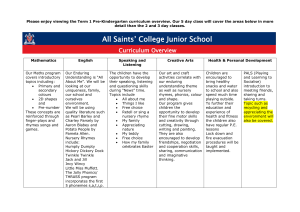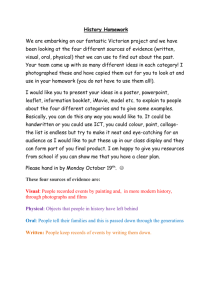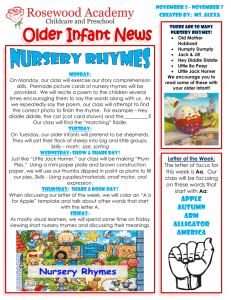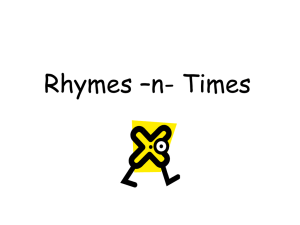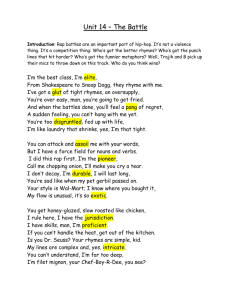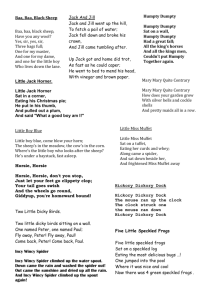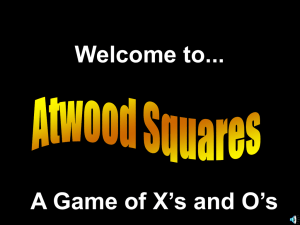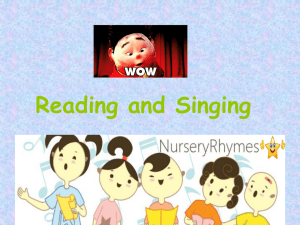Mother Goose
advertisement
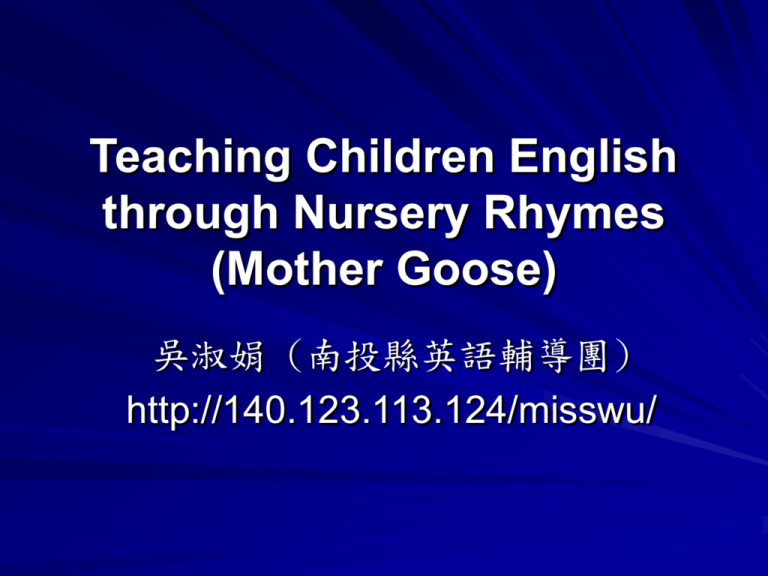
Teaching Children English through Nursery Rhymes (Mother Goose) 吳淑娟 (南投縣英語輔導團) http://140.123.113.124/misswu/ Introduction Karen Galeano (1983) Elementary ESL teachers have known for years that comprehensible input is the best way to teach language…..Small children will simply not tolerate what is not meaningful to them. Alexander Bessmertnyi (1994): In choosing meaningful language for use in the ESL classroom, one can do no better than look to a popular old standby, Mother Goose. Why nursery rhymes (1)? It tells a story. surprise value (e.g.: Peter Peter Pumpkin Eater); interesting characters (e.g.: Jack Spratt) meaningful conflicts (e.g. Little Miss Muffet); action (e.g.: Humpty Dmpty) relate to the real world of the students they are aimed at (e.g. Mary Had a Little Lamb) Why nursery rhymes (2)? The natural rhythms of the poems helps intonation in English. (e.g.: Jack & Jill) It is an excellent medium for a variety of teaching techniques which make the classroom into a stimulating learning environment. The rhymes help children regain vocabulary. Why nursery rhymes (3)? Mother Goose has been enjoyed by children since 1697. Mother Goose rhymes are an important part of American culture, and as such should be taught. Mother Goose rhymes and songs helps students practice the linking of the sounds and the speed reading, e.g.: Three Blind Mice (Angela, 2004) “Mamamia! It’s a nightmare!” to check on Internet at least 10 American folk songs to check on Internet about Raffi; to watch the films of Shrek I and Shrek II; to download the lyrics for Six Little Ducks to make a riddle from a nursery rhyme make a little book with lyrics variation in any of the nursery rhymes; (I’ve been working on the railroad vs. I’ve been studying in the classroom) “I am driven nuts!” make a big book with the introduction of some Mother Goose (see example) except for memorizing and performing the required 40 pieces of Mother Goose, perform one of the 40 nursery rhymes in a rock-and-roll style (Angela said, “Are you driving me nuts?”) To present a project (e.g.: Green Grass Grows All Around) Make a worksheet out of a nursery rhyme Media Introduced by Dr. Chang Raffi; Barney’s Rhyme Time Mother Goose Rocks (http://www.mothergooserocks.com/ ) Yellow Submarine Mamma Mia! Conclusion The Mother Goose rhymes offer a wealth of topics, and a wealth of springboards to learning vocabulary and other language skills. After almost two hundred years, they still hold children’s interest and provide ways to learn about their world. (Karen Galeano, 1983) Peter Peter Pumpkin Eater Peter, Peter, pumpkin eater Had a wife but couldn’t keep her He put her in a pumpkin shell And there he kept her very well Jack Spratt Jack Spratt could eat no fat, His wife could eat no lean; And so between the two of them, They licked the platter clean. Little Miss Muffet Little Miss Muffet sat on a tuffet Eating her curds and whey Along came a spider who sat on beside her And frightened Miss Muffet away Humpty Dumpty Humpty Dumpty sat on a wall Humpty Dumpty had a great fall All the king’s horses and all the king’s men Couldn’t put Humpty together again Mary had a Little Lamb Mary had a little lamb, Little lamb, little lamb, Mary had a little lamb, Its fleece was white as snow And everywhere that Mary went, Mary went, Mary went, Everywhere that Mary went The lamb was sure to go Jack & Jill Jack and Jill went up the hill to fetch a pail of water Jack fell down and broke his crown And Jill came tumbling after Then up got Jack and said to Jill As in his arms he took her, “Brush off that dirt for you’re not hurt Let’s fetch that pail of water.” Three Blind Mice Three blind mice Three blind mice See how they run See how they run They all run after the farmer’s wife Who cut off their tails with a carving knife Did you ever see such a thing in your life As three blind mice Six Little Ducks Six little ducks That I once knew Fat ones, skinny ones, Fair ones, too But the one little duck With the feather on his back He led the others With a quack, quack, quack Quack, quack, quack, Quack, quack, quack He led the others With a quack, quack, quack I am a Little Tea Pot I am little tea pot Short and stout Here is my handle Here is my spout When I get all steamed up I just shout Tip me over and pour me out I’ve been Working on the Railroad I’ve been working on the railroad all the living long day I’ve been working on the railroad just to pass the time away Can’t you hear the whistle blowing Rise up so early in the morn Can’t you hear the captain shouting, “Dinah, blow your horn”. Dinah, won’t you blow? (x2) Dinah, won’t you blow your horn? Someone's in the kitchen with Dinah. Someone's in the kitchen, I know. Someone's in the kitchen with Dinah Strumming on the old banjo. I’ve been Studying in the Classroom I’ve been studying in the classroom All the live long day I’ve been studying in the classroom Just to passLet’s the time away Can’t you hear the teacher shouting, “Jackie, stop dreaming” (x2) Jackie, stop dreaming (x2) Jackie won’t you stop day dreaming… An Introduction to Book 1, Lollipop English Brainstorm Group 吳淑娟 (愛蘭) 許富美 (南投, 已調至台中) 吳梅菁 (炎峰, 已調至屏東) 林俊宏 (炎峰) 劉宜 (碧峰, 已調至漳和) 許純琦 (南光) An Introduction to Book 1, Lollipop English Contents: Student Book Let’s Sing, Let’s Chant, Let’s Do it, Review, Activity Activity Book (親子手冊) Big Book Flash cards CD An Introduction to Book 1, Lollipop English 錄音小組成員: 一上: Joshua, Natasha,吳淑娟,王瑩, 許瑞蘭 一下: Juliana, Zach, 吳淑娟 Book 1 內容: What’s your name? How are you? Feelings Review 1 Numbers Stationery Review 2 (Halloween & Christmas) Thanks for your attention!

